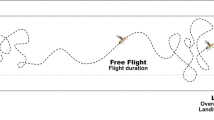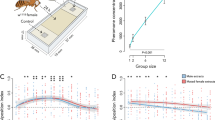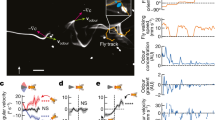Abstract
“Moths display some of the most striking examples of long-distance chemical communication in the animal kingdom”1. Recent theories of how the male moths find a distant female have invoked steering by two different directional cues: (1) gradients of odour concentration in the air, used in ‘aerial odour-trail following’, and (2) the wind, used in ‘odour-modulated anemotaxis’2–7. Laboratory evidence has favoured the latter theory as well as contradicting the earlier radiation theories8–11, but the issue could not be settled without recording in the field the flight track of a male moth and, simultaneously, the track of the odour plume. This has now been done with gypsy moths and wind-borne bubbles, confirming theory (2) and showing in addition that cross-wind casting itself contributes to a moth's progressive approach to the odour source, an unexpected consequence of the way odours are dispersed by the wind12.
This is a preview of subscription content, access via your institution
Access options
Subscribe to this journal
Receive 51 print issues and online access
$199.00 per year
only $3.90 per issue
Buy this article
- Purchase on Springer Link
- Instant access to full article PDF
Prices may be subject to local taxes which are calculated during checkout
Similar content being viewed by others
References
Greenfield, M. D. Florida Ent. 64, 4–17 (1981).
Shorey, H. H. Animal Communication by Pheromones (Academic, New York, 1976).
Farkas, S. R. & Shorey, H. H. in Pheromones (ed. Birch, M. C.) 81–95 (Elsevier, Amsterdam, 1974).
Finch, S. in Applied Biology Vol. 5 (ed. Coaker, T. H.) 67–143 (Academic, London, 1980).
Kennedy, J. S. in Chemical Control of Insect Behaviour: Theory and Application (eds Shorey, H. H. & McKelvey, J. J.) 67–91 (Wiley, New York, 1977).
Marsh, D., Kennedy, J. S. & Ludlow, A. R. Physiol. Ent. 3, 221–240 (1978).
Kennedy, J. S., Ludlow, A. R. & Sanders, C. J. Physiol Ent. 6, 395–412 (1981).
Laithwaite, E. R. Entomologist 93, 113–117, 133–137 (1960).
Callahan, P. S. Misc. Publs ent. Soc. Am. 5, 315–417 (1967).
Hsiao, H. S. J. Insect Physiol. 18, 1705–1714 (1972).
Diesendorf, M., Stange, G. & Snyder, A. W. Proc. R. Soc. B185, 33–49 (1974).
David, C. T., Kennedy, J. S., Ludlow, A. R., Perry, J. N. & Wall, C. J. chem. Ecol. 8, 1207–1215 (1982).
Mori, K., Takigama, T. & Matsui, M. Tetrahedron Lett. 44, 3953–3956 (1976).
Rothschild, G. H. L. & Minks, A. K. Envir. Ent. 3, 1003–1007 (1974).
Murlis, J. & Bettany, B. W. Nature 268, 433–435 (1977).
Author information
Authors and Affiliations
Rights and permissions
About this article
Cite this article
David, C., Kennedy, J. & Ludlow, A. Finding of a sex pheromone source by gypsy moths released in the field. Nature 303, 804–806 (1983). https://doi.org/10.1038/303804a0
Received:
Accepted:
Issue Date:
DOI: https://doi.org/10.1038/303804a0
This article is cited by
-
Olfactory navigation in arthropods
Journal of Comparative Physiology A (2023)
-
A neural circuit for wind-guided olfactory navigation
Nature Communications (2022)
-
Multimodal interactions in insect navigation
Animal Cognition (2020)
-
Spatial memory-based behaviors for locating sources of odor plumes
Movement Ecology (2015)
-
Large Roads Disrupt Insect Movement: A Case Study of the Spodoptera littoralis (Lepidoptera: Noctuidae)
Journal of Insect Behavior (2015)
Comments
By submitting a comment you agree to abide by our Terms and Community Guidelines. If you find something abusive or that does not comply with our terms or guidelines please flag it as inappropriate.



